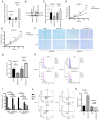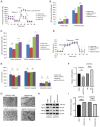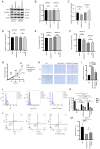SUCLG1 promotes aerobic respiration and progression in plexiform neurofibroma
- PMID: 39749698
- PMCID: PMC11753773
- DOI: 10.3892/ijo.2024.5716
SUCLG1 promotes aerobic respiration and progression in plexiform neurofibroma
Abstract
Plexiform neurofibromas (PNFs) are benign tumors that affect 20‑50% of patients with type I neurofibromatosis (NF1). PNF carries a risk of malignancy. There is no effective cure for PNF. Its onset may be associated with genetic and metabolic abnormalities, but the exact mechanisms remain unclear. Succinate‑CoA ligase GDP/ADP‑Forming Subunit α(SUCLG1), a catalytic enzyme in the tricarboxylic acid cycle, is highly expressed in PNF. The present study aimed to explore the role of SUCLG1 in function and metabolism of PNF cells. SUCLG1 expression was verified using western blotting and immunofluorescence. After inducing SUCLG1 knockdown and overexpression, functional changes in PNF cells were assessed, as well as effects of SUCLG1 on cell respiration and glucose metabolism. Quantitative PCR, WB, electron microscopy and Flow cytometry demonstrated that SUCLG1 enhanced mitochondrial quality and promoted mitochondrial fusion, thereby driving proliferation and migration of tumor cells, inhibiting apoptosis and altering the cell cycle. A Seahorse assay showed that elevated SUCLG1 expression enhanced cell aerobic respiration without affecting the glycolytic process. This suggests that SUCLG1 upregulation in PNF does not trigger the Warburg effect associated with malignant tumors. This study also demonstrated the positive regulation of cellular function by promoting the expression level of the SLC25A1 gene when SUCLG1 expression was elevated. In conclusion, SUCLG1 altered the mechanism of mitochondrial quality control to enhance cell aerobic respiration, thereby driving the pathogenesis of PNF. Thus, SUCLG1 can serve as a potential target in future therapeutic strategies.
Keywords: aerobic respiration; mitochondria; neurofibromatosis type 1; plexiform neurofibroma; tricarboxylic acid cycle.
Conflict of interest statement
The authors declare that they have no competing interests.
Figures





Similar articles
-
Reduced PTPRS expression promotes epithelial-mesenchymal transition of Schwann cells in NF1-related plexiform neurofibromas.Cancer Lett. 2024 Sep 1;599:217151. doi: 10.1016/j.canlet.2024.217151. Epub 2024 Jul 31. Cancer Lett. 2024. PMID: 39094827
-
Increased nuclear translation of YAP might act as a potential therapeutic target for NF1-related plexiform neurofibroma.Int J Med Sci. 2021 Mar 3;18(9):2008-2016. doi: 10.7150/ijms.52431. eCollection 2021. Int J Med Sci. 2021. PMID: 33850471 Free PMC article.
-
Dual mTORC1/2 inhibition induces anti-proliferative effect in NF1-associated plexiform neurofibroma and malignant peripheral nerve sheath tumor cells.Oncotarget. 2016 Jun 14;7(24):35753-35767. doi: 10.18632/oncotarget.7099. Oncotarget. 2016. PMID: 26840085 Free PMC article.
-
Modeling tumors of the peripheral nervous system associated with Neurofibromatosis type 1: Reprogramming plexiform neurofibroma cells.Stem Cell Res. 2020 Dec;49:102068. doi: 10.1016/j.scr.2020.102068. Epub 2020 Oct 29. Stem Cell Res. 2020. PMID: 33160273 Review.
-
Unilateral Creeping Destruction of Deformed Mandibular Ramus and Angle Associated with Extensive Facial Plexiform Neurofibroma in Neurofibromatosis Type 1: A Case Report with Analysis of the Literature for Diagnosing Osteolytic Events of the Mandible in Tumor-suppressor Gene Syndrome.Anticancer Res. 2018 Jul;38(7):4083-4091. doi: 10.21873/anticanres.12698. Anticancer Res. 2018. PMID: 29970534 Review.
References
-
- Gross AM, Glassberg B, Wolters PL, Dombi E, Baldwin A, Fisher MJ, Kim A, Bornhorst M, Weiss BD, Blakeley JO, et al. Selumetinib in children with neurofibromatosis type 1 and asymptomatic inoperable plexiform neurofibroma at risk for developing tumor-related morbidity. Neuro Oncol. 2022;24:1978–1988. doi: 10.1093/neuonc/noac109. - DOI - PMC - PubMed
MeSH terms
Substances
LinkOut - more resources
Full Text Sources
Research Materials
Miscellaneous

